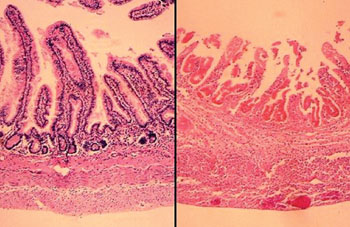Severe Anemia Associated with Increased Risk of Necrotizing Enterocolitis
By LabMedica International staff writers
Posted on 16 Mar 2016
Necrotizing enterocolitis (NEC) an acute, life-threatening, inflammatory disease occurring in the intestines of premature infants, is a leading cause of mortality among preterm infants with case-fatality rates of 20% to 30% yet the origin and development of NEC remains unclear.Posted on 16 Mar 2016
There is conflicting data regarding the role of two risk factors, red blood cell (RBC) transfusion and anemia. Improving understanding of the role of RBC transfusion and anemia is important because more than half of among very low-birth-weight (VLBW) infants (1,500 grams or less) receive one or more transfusions during hospitalization.

Image: Histopathology comparing normal bowel at the left, to a bowel involved by necrotizing enterocolitis (NEC) at the right showing hemorrhagic necrosis, beginning in the mucosa and extending to involve the muscular wall, with the potential for perforation (Photo courtesy of the University of Utah School of Medicine).
Scientists at the Emory University School of Medicine (Atlanta, GA, USA) and their colleagues enrolled VLBW infants at three neonatal intensive care units in Atlanta within five days of birth. Infants received follow-up until 90 days, hospital discharge, transfer to a non-study-affiliated hospital, or death (whichever came first). Of 600 VLBW infants enrolled in the study 598 were evaluated from January 2010 to February 2014. The primary exposure was RBC transfusion. The secondary exposure was severe anemia, defined a priori as a hemoglobin level of 8 g/dL or less. Both exposures were evaluated as time-varying covariates at weekly intervals.
In the study 319(53%) infants received a total of 1,430 RBC transfusion exposures, 44 (7.4 %) infants developed NEC and 32 (5.4%) infants died (all causes). The unadjusted cumulative incidence of NEC at week eight among RBC transfusion-exposed infants was 9.9% versus 4.6% among those who were unexposed. In multivariable analysis, RBC transfusion in a given week was not significantly related to the rate of NEC. Based on evaluation of 4,565 longitudinal measurements of hemoglobin (median, 7 per infant), the rate of NEC was significantly increased among VLBW infants with severe anemia in a given week compared with those who did not have severe anemia.
The authors concluded that because severe anemia, but not RBC transfusion, was a risk factor for NEC in the study, preventing severe anemia may be more clinically important than minimizing RBC transfusion exposure as a strategy to decrease the risk of NEC. However, the effect of such a strategy on other important neonatal outcomes is unclear, and further study is needed. Ongoing clinical trials comparing liberal versus conservative transfusion practices may provide additional experimental data regarding the risks of both severe anemia and RBC transfusion to NEC. The study was published on March 1, 2016, in the Journal of the American Medical Association.
Related Links:
Emory University School of Medicine














